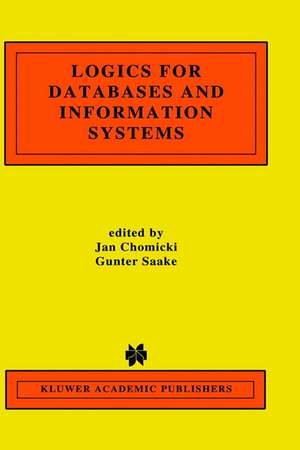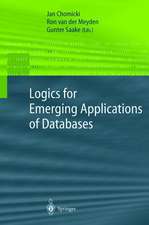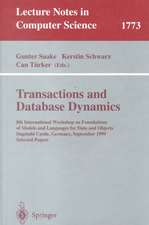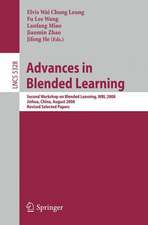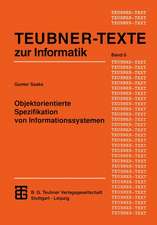Logics for Databases and Information Systems: The Springer International Series in Engineering and Computer Science, cartea 436
Editat de Jan Chomicki, Gunter Saakeen Limba Engleză Hardback – 31 mar 1998
| Toate formatele și edițiile | Preț | Express |
|---|---|---|
| Paperback (1) | 1279.20 lei 6-8 săpt. | |
| Springer Us – 21 oct 2012 | 1279.20 lei 6-8 săpt. | |
| Hardback (1) | 1285.45 lei 6-8 săpt. | |
| Springer Us – 31 mar 1998 | 1285.45 lei 6-8 săpt. |
Din seria The Springer International Series in Engineering and Computer Science
- 24%
 Preț: 1041.97 lei
Preț: 1041.97 lei - 20%
 Preț: 643.50 lei
Preț: 643.50 lei - 18%
 Preț: 1225.62 lei
Preț: 1225.62 lei - 18%
 Preț: 965.02 lei
Preț: 965.02 lei - 20%
 Preț: 646.12 lei
Preț: 646.12 lei - 18%
 Preț: 948.79 lei
Preț: 948.79 lei - 20%
 Preț: 646.62 lei
Preț: 646.62 lei - 15%
 Preț: 637.46 lei
Preț: 637.46 lei - 20%
 Preț: 643.83 lei
Preț: 643.83 lei - 18%
 Preț: 949.23 lei
Preț: 949.23 lei - 20%
 Preț: 644.48 lei
Preț: 644.48 lei - 20%
 Preț: 994.92 lei
Preț: 994.92 lei - 20%
 Preț: 645.97 lei
Preț: 645.97 lei - 18%
 Preț: 946.87 lei
Preț: 946.87 lei - 20%
 Preț: 995.57 lei
Preț: 995.57 lei - 18%
 Preț: 956.99 lei
Preț: 956.99 lei - 20%
 Preț: 644.98 lei
Preț: 644.98 lei - 15%
 Preț: 649.54 lei
Preț: 649.54 lei - 18%
 Preț: 950.21 lei
Preț: 950.21 lei - 18%
 Preț: 1221.38 lei
Preț: 1221.38 lei - 18%
 Preț: 957.62 lei
Preț: 957.62 lei - 15%
 Preț: 643.99 lei
Preț: 643.99 lei - 18%
 Preț: 948.47 lei
Preț: 948.47 lei - 18%
 Preț: 947.35 lei
Preț: 947.35 lei - 20%
 Preț: 1284.65 lei
Preț: 1284.65 lei - 20%
 Preț: 1628.31 lei
Preț: 1628.31 lei - 20%
 Preț: 1285.78 lei
Preț: 1285.78 lei
Preț: 1285.45 lei
Preț vechi: 1606.82 lei
-20% Nou
Puncte Express: 1928
Preț estimativ în valută:
245.96€ • 256.81$ • 203.57£
245.96€ • 256.81$ • 203.57£
Carte tipărită la comandă
Livrare economică 04-18 aprilie
Preluare comenzi: 021 569.72.76
Specificații
ISBN-13: 9780792381297
ISBN-10: 0792381297
Pagini: 430
Ilustrații: XIII, 430 p.
Dimensiuni: 155 x 235 x 25 mm
Greutate: 0.8 kg
Ediția:1998
Editura: Springer Us
Colecția Springer
Seria The Springer International Series in Engineering and Computer Science
Locul publicării:New York, NY, United States
ISBN-10: 0792381297
Pagini: 430
Ilustrații: XIII, 430 p.
Dimensiuni: 155 x 235 x 25 mm
Greutate: 0.8 kg
Ediția:1998
Editura: Springer Us
Colecția Springer
Seria The Springer International Series in Engineering and Computer Science
Locul publicării:New York, NY, United States
Public țintă
ResearchCuprins
1 Introduction to Logics for Databases and Information Systems.- References.- 2 A Logic Primer.- 2.1 Introduction.- 2.2 First-Order Logic (FOL).- 2.3 Modal Logics.- 2.4 Logic Programming.- 2.5 Conclusion.- References.- 3 Temporal Logic in Information Systems.- 3.1 Introduction.- 3.2 Temporal Databases.- 3.3 Temporal Queries.- 3.4 Temporal Integrity Constraints.- 3.5 Multidimensional Time.- 3.6 Beyond First-order Temporal Logic.- 3.7 Conclusions.- References.- 4 The Role of Deontic Logic in the Specification of Information Systems.- 4.1 Introduction: Soft Constraints and Deontic Logic.- 4.2 Standard Deontic Logic (SDL).- 4.3 The Paradoxes of Deontic Logic.- 4.4 A Diagnosis of the Problems.- 4.5 A Solution to the ‘Ought-to-Be’ Version of the Chisholm Paradox: S5O(n).- 4.6 Ought-to-Do: The Dynamic Perspective.- 4.7 An Integrated Logic of Ought-to-Be and Ought-to-Do Constraints.- 4.8 Applications.- References.- 5 A Logic for Programming Database Transactions.- 5.1 Introduction.- 5.2 Overview and Introductory Examples.- 5.3 Syntax.- 5.4 Elementary Operations.- 5.5 Model Theory.- 5.6 Proof Theory.- 5.7 Related Work.- References.- 6 Logics for Specifying Concurrent Information Systems.- 6.1 Introduction.- 6.2 Overview.- 6.3 Local Logic L.- 6.4 Distributed Logics.- 6.5 Reduction.- 6.6 Extended Example.- 6.7 Related Work.- 6.8 Concluding Remarks.- References.- 7 Evolving Logical Specification in Information Systems.- 7.1 Introduction.- 7.2 Motivation and Language.- 7.3 Syntax and Semantics of the Logic.- 7.4 Translation of Language into Logic.- 7.5 Using the Logical Framework.- 7.6 Concluding Remarks.- References.- 8 Description Logics for Conceptual Data Modeling.- 8.1 Introduction.- 8.2 Description Logics.- 8.3 Semantic Data Models.- 8.4 Object-Oriented Data Models.- 8.5Support for Data Modeling.- 8.6 Conclusions.- References.- 9 Integrity Constraints: Semantics and Applications.- 9.1 Introduction.- 9.2 Background.- 9.3 Semantics of Integrity Constraints.- 9.4 Reasoning with Integrity Constraints.- 9.5 Applications of Integrity Constraints.- 9.6 Conclusion and Future Directions.- References.- 10 Logical Approaches to Incomplete Information: A Survey.- 10.1 Introduction.- 10.2 Sources of Indefiniteness.- 10.3 A Semantic Framework for Incomplete Databases.- 10.4 Algebraic Models of Nulls.- 10.5 Logical Databases.- 10.6 Complexity of Queries.- 10.7 Negative Information.- 10.8 Integrity Constraints.- 10.9 Updates of Incomplete Databases.- 10.10 Other Issues.- 10.11 Incomplete Information in Current Technology.- References.- 11 Declarative Frameworks for Inheritance.- 11.1 Introduction.- 11.2 Motivation for Inheritance.- 11.3 Main Issues and Problems.- 11.4 Logic-based Approaches to Inheritance.- 11.5 Research Directions.- References.- 12 On Logical Foundations of Active Databases.- 12.1 Introduction.- 12.2 Basics of Active Rules.- 12.3 Research on Foundations of Active Rules.- 12.4 A Deductive State-Oriented Core Language.- 12.5 A Framework for Active Rules.- 12.6 Conclusion.- References.
